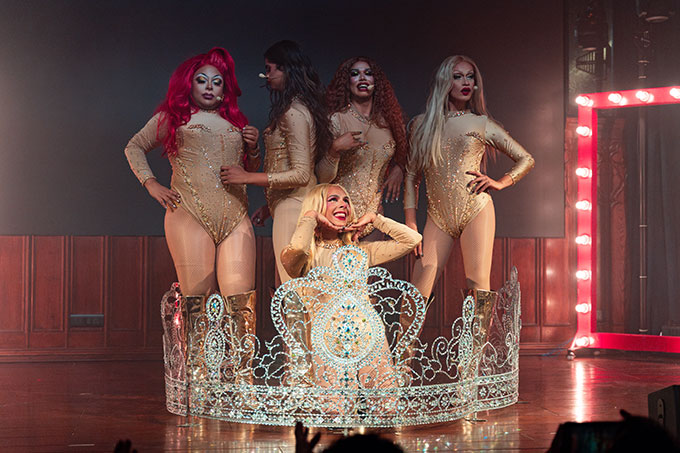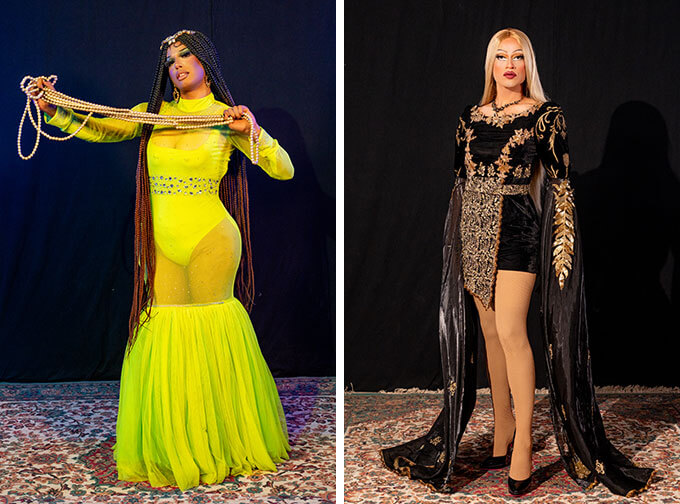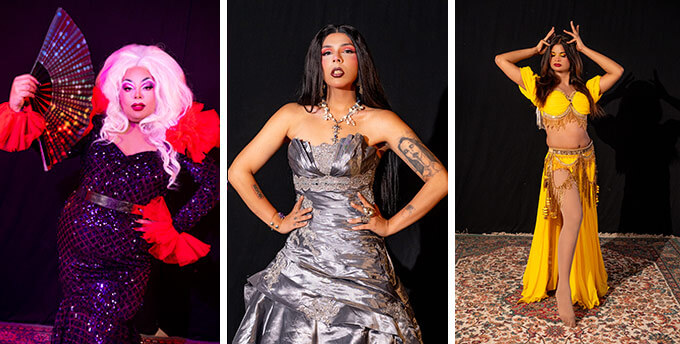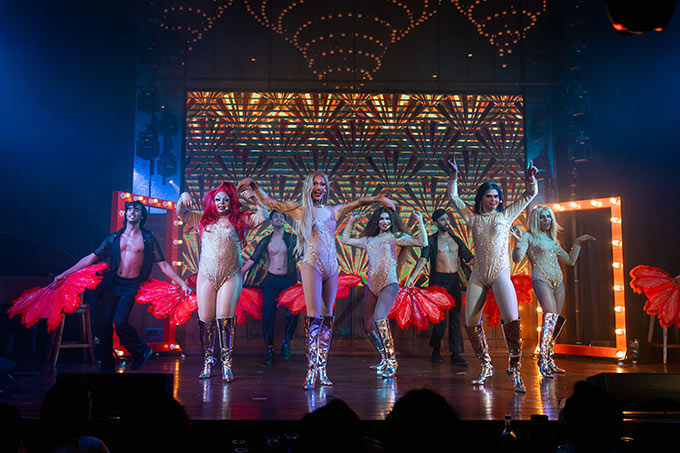Beyond the resounding success of Superqueens the Musical, into drag as work. Contracts, parties, dancing chops, safety, artistry, hair, makeup and costumes. Worth and wounds too
“Behn”, she shouts. It is Whacker Cracker, her voice of a sultry transwoman, timbred and textured. She is “arriving” (present continuous in vibe) in pale blue ripped jeans, a black crop top, red lipstick and waist length hair. Other behns, sisters, in this sisterhood of five, giggle. The evening’s energy spikes up, cutting through the July humidity at the outdoors seating area of The Piano Man jazz club and concept café in Delhi. “We rule the room wherever we are,” says one. “We have a desire to be seen,” says another.
It’s been more than a week since Superqueens the Musical became a surprise smash. Directed by veteran theatre artist Vivek Mansukhani, it spotlighted drag as both spectacle and substance. With Whacker Cracker—real name Paridhi Chauhan—are fellow queens: Aishwarya Ayushman aka Lush Monsoon, Pratik aka Betta Naan Stop, Teya aka Sickk, and Reggie Sandhu, also known as Hash Brownie.
Mansukhani is with us too. A veteran theatre actor, director and writer, he is gushy proud. Anxious and wired. About the fine art of doing justice to drag as an art. To the real and performative personas of these drag queens. He has been worrying himself “Sickk” over the representational poignance of their queerness. Read Mansukhani’s first person account from a director’s point of view here.

Shifting The Lens
This story though, is not a review of the musical. It’s a look beyond it—at drag as labour, hustle, craft, and choice. It became an instant hit because of the way it meshed queer identity and meaning without becoming glib. Or, turning it into an erotic or kitschy spectator sport. There was all of that of course—the sexiness, the wink-wink, the padded boobs, brash bras, the glittering costumes, taped genitals, gowns that glowed over the jazz club’s jazz, higher than high heels, whimsical makeup. So much so, that Lush Monsoon who is here now in his shirt, trousers and backpack, his non-drag self, that of a human rights lawyer or Betta Naan Stop, a dancer and event manager, casually attired, look unrecognisable.
But there was something else in the musical. An undercurrent. The script let you into a core concern. A fictitious club resembles a real life employment platform; it cancels upcoming shows of the drag queens, giving them a week to transit away from their contracts. That week becomes one of contemplation, of threatened employment and survival. Where the drag queens review their business: vie for new contracts, go through a media interview, a fashion brand campaign; debate house rents, the money that bleeds into their makeup and hair, the competition in the market of queer art. Most importantly nurse and nurture the “need to be seen”

The Business of Drag
While Lush is a human rights lawyer and Betta Naan Stop, a dancer and events manager who books drag nights, he calls himself a full time drag artist. He has a sharp, chiselled face, shaped as if, by a sculptor. Most of all, he seems emotive about his sentiments.
Hash Brownie is now a makeup developer, costumer and makeup person, curly haired, in a tiger print top, pleated pants, heels and glossy brown lipstick. Teya, on the other hand, who goes by the drag name of Sickk runs ATHI (Association for Trans Health in India) co-founded by her father. Whacker Cracker, the youngest is funny and flirtatious, tall and athletic. She says she is hustling all the time. For meaningful and enjoyable work. She is an avid dancer, a DJ too and makes music.
Delhi is no stranger to drag entertainment. Weddings, kitty parties, divorce parties, LGBTQ nights, drag events hosted by queens who are paid to have live conversations with guests, these roll out in the capital. Some in secretive glee, others openly to “entertain” those perplexed by the exotic and the erotic dazzle of sex, gender and body. Some get paid Rs 2000 per gig as a starting rate. Others will fetch up to Rs 40,000 a night or more. Whatever the fees, payments come after 40 days as for most freelancers in today’s gig economy. Not all events are safe as gender violence is a persistent threat in Delhi; not all event managers offer transport or support.

Sometimes the sisterhood is booked as a group. Other times, one of them gets a song, the rest go without work. Drag, in India, is not an organised industry. Nor is it sustainable as a sole income source. Most of the queens have day jobs or rely on family to offset rent and healthcare costs. While Betta and Sickk live with their parents, which helps cut down costs of living and rent, others are self-dependent.
Unlike scripted shows like Superqueens, most drag performances in the city are raw. No rehearsals, no stage design. You’ll find drag brunches, ‘Heeramandi’ nights at Depot48, ‘Pure Love Thursdays’ at The Lalit. Some meme-based events masquerade as queer-friendly but are cutthroat in competition.
Whacker Cracker says it helps that Lush and Betta do bookings for this sisterhood—it creates a safety net and an assurance. Even so, they admit the events they are contracted for, are clapped into a cliché, repetitive, nervous cracks of a life of denial presumed by the audience.
Yet, the drag performances they lust for, are not only ways of making a living but also a way of living real selves. “Doing drag felt like taking a Ganga dip. It made me confident in a way nothing else had,” says Betta Naan Stop.
The reflection is not just a spiritual identification with a life in makeup and drag because even when it is at its most vulnerable, it must find ways to earn, buy healthcare and retain selfhood. Ayushman or Lush, a lawyer, says he came to Delhi to pursue theatre, after completing his law degree. “In theatre I didn’t find the right space for a queer person like me. The roles were binary—of a man; whereas the female role was not available to me. I found Delhi’s fashion scene selective and theatre traditional. Plays that had been written ages back were still being staged,” he says.
A prominent director at the National School of Drama advised Lush to “side hustle” and try drag without leaving his full time work as a lawyer. “Being a drag artist means that there are periods where you don’t have any gigs or anything to excite you about. Plus, there was nothing innovative or pathbreaking left to do. That’s why we wanted to create Superqueens and approached Vivek. Not just for the commercial need but because we had tried and exhausted every gig, every idea.”
Drag is Armour, not Just Work
While the queens have been doing drag for five to six years now, each has a reason that waltzes between the commercial and the personal. What surfaces in their stories is not scarring. The wounds they may have nursed in discriminative and hurtful experiences as non-binary persons or the lack of sexual safety experienced in queer lives are present but they are not blistering. That was also the win of the musical, which retold the complexities of their lives, rejection, apprehension and sexual anxiety in an unburdened way. Sexy and wry, minus sadism.
Remarkably, the skein and skin of these five drag queens seem inseparable. The mask is also the pacemaker. Mansukhani polished and elevated it. “Whacker Cracker and Paridhi are not opposites. They’re literally the same person,” she says. “One just has more energy with makeup.” Her eyes gleam. “I started drag because I wanted to be a star.”
“It’s the audacity. Of showing up as the loudest, most out-there version of yourself when most people try to blend in,” Betta Naan Stop.
This fusing of the selves, one real, the other performative is a deliberation hard to discover in life for many. Queens or slaves to life.
“People wonder why anyone would squeeze into a corset and dance in heels,” says Lush. “But we find joy in those exaggerations of masculinity and femininity. That’s where we locate ourselves.” He stumbled into his identity in a proto drag way, while trying out a wig.
Hash Brownie nods. “Makeup was my hideaway. Without it, I don’t think I’d survive.”
She grew up in a traditional Sikh family, bi-racial—half Black, half Sikh. Started working at 17 in a call centre. Makeup and fashion became escape, then armour. Her family struggled with her identity, uncomfortable with her clothes, makeup, late nights. She moved out to make a life of her own. Now she’s a costumer, makeup artist—and the designer behind Superqueens’ dazzling wardrobe.
Healing The Sickk
“Everything I do aligns with self-expression,” says Sickk. That includes NGO trainings, jokes she cracks, or drag hosting gigs. “Same muscle. Same connection,” she says explaining her work at the NGO for Trans health established by her father. She’s wearing brown trousers with pink hearts, a faux leather jacket, a pink crop top. Style radiates from her—as her brand and her belief.The Art of Drag
“Everything I do aligns with self-expression,” says Sickk. That includes NGO trainings, jokes she cracks, or drag hosting gigs. “Same muscle. Same connection,” she says explaining her work at the NGO for Trans health established by her father. She’s wearing brown trousers with pink hearts, a faux leather jacket, a pink crop top. Style radiates from her—as her brand and her belief.
“People call us media queens,” she shrugs, “but very few ask about our art.” Whacker agrees. “People don’t know what we go through to give those two minutes of magic. I call drag the Olympics of artforms.”
“It’s the audacity. Of showing up as the loudest, most out-there version of yourself when most people try to blend in,” adds Betta.
As a bunch they are multi-hyphenated: dancer-activist-lawyer-makeup artist-costume designer. But they’re clear—being in drag doesn’t make you an artist. It takes work.

The Art of Drag
“We may not be the best singers, the best makeup artists or the best seamstresses, and not everybody will be best in everything but the sum total is greater than the individual things combined,” says Betta.
The resonance this writer feels with this sisterhood is also because of their inherent sense of style. Not the style of artificial lashes, or crazy wigs like Lush Monsoon’s in the musical—white blond or deep red. But the style that surfaces from an unselfconscious mix of satire and simplicity. Something fashion cannot better.
Who Should Try Drag
Drag, in this sisterhood, isn’t just about dressing up. It is about dressing wounds, reclaiming lost scripts, and stumbling into new ones. It is also about showing up—on stage, on call, in costume and in character. As Whacker Cracker might say, it’s about turning the world into your own runway.
Their business is about performance, but perhaps they might remain in business because of perseverance.
“Everyone can do drag, Betta says in the musical. “But not everyone should.” Because doing drag, as it turns out, is not about becoming someone else. It’s about owning up who you are—and daring the world to deal with it.





